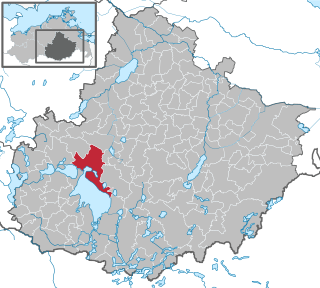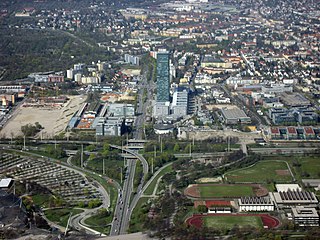
Pasing Town Hall (German : Rathaus Pasing) is the former town hall of the municipality of Pasing, Bavaria, Germany, which was incorporated into Munich in 1938.

Pasing Town Hall (German : Rathaus Pasing) is the former town hall of the municipality of Pasing, Bavaria, Germany, which was incorporated into Munich in 1938.
The municipality administration of Pasing was located, from 1901, in the then fire station on Bäckerstraße. After the 1905 city inspection, the town hall was planned to be built on the Marienplatz in Pasing.
For reasons of space and cost, however, the building was erected on the then Münchner Straße (today Landsberger Straße). After a construction period of fifteen months, the town hall was handed over to the Pasinger Lord Mayor Alois Wunder, on the 15 of November 1937. Unfortunately, the city of Pasing lost its independence only six months later and was incorporated as a district of Munich on 1 April 1938.
During the Second World War, the western wing was destroyed by a bomb in 1944 and the eastern part by an air mine in 1945. After the war, and during the period of office of the Mayor of Munich, Thomas Wimmer, the building was restored to its original form.
The Pasing town hall with 75 rooms, sitting room and adjoining rooms was built according to the plans of the architects Volbehr and Rettig for 450,000 Reichsmark.
In the council hall still hangs a tapestry of the Nazi artist Bruno Goldschmitt from the year 1938. [1]
On 7 October 2002, the new building for 12.5 million Euro, built according to the plans of the architects Landau and Kindlbacher, including 49 rooms and a new wedding room, was opened.
In front of the town hall, the wedding fountain, created by the Pasinger sculptor Hans Osel, was erected in 1963.
The present town hall of Pasing was the only one of Munich's municipal authorities, which was directly subordinated to the mayor of Munich. This status was guaranteed until 31 March 2005 by the General Agreement of 8 January 1938. On the request of Lord Mayor Christian Ude, this contract was eliminated by the City Council and handed over to the Directorate, Social Council and District Administration Council.
Presently, the District Inspectorate, a Citizen's Office, the Municipal Office, the Social Office and the District Committee 21 are accommodated here.
The Pasing town hall was, in 1986, the world's first communal facility equipped with ISDN. [2]

Königsplatz is a square in Munich, Germany. Built in the style of European Neoclassicism in the 19th century, it displays the Propyläen Gate and, facing each other, the Glyptothek and the Staatliche Antikensammlungen. The area around Königsplatz is home to the Kunstareal, Munich's gallery and museum quarter.

Waren (Müritz) is a town and climatic spa in the state of Mecklenburg-Vorpommern, Germany. It was the capital of the former district of Müritz until the district reform of 2011. It is situated at the northern end of Lake Müritz, approximately 40 kilometres west of Neubrandenburg. Waren is home to the offices of the sub-district (Amt) of Seenlandschaft Waren, although the town itself is independent of any Amt. Its borough is the second largest in Mecklenburg-Vorpommern by area.

Vienna City Hall is the seat of local government of Vienna, located on the Rathausplatz in the Innere Stadt district. Constructed from 1872 to 1883 in a neo-Gothic style according to plans designed by Friedrich von Schmidt, it houses the office of the Mayor of Vienna, as well as the chambers of the city council and Vienna Landtag diet.

Munich-Pasing is a railway station in the west of Munich. It is the third-largest station in the city, after München Hauptbahnhof and München Ost.

The New Town Hall is a town hall that forms the northern part of Marienplatz in Munich, Bavaria, Germany. It hosts the city government including the city council, offices of the mayors and a small portion of the administration. In 1874 the municipality had left the Old Town Hall for its new domicile.

This article gives an overview about the architecture of Munich, Germany.

The neoclassical Brienner Straße in Munich is one of four royal avenues next to the Ludwigstraße, the Maximilianstraße and the Prinzregentenstraße. The boulevard was constructed from 1812 onwards, during the reigns of Maximilian I Joseph of Bavaria and his successor Ludwig I, in accordance with a plan by Karl von Fischer and Friedrich Ludwig von Sckell. The avenue is named after the Battle of Brienne.

Hamburg City Hall is the seat of local government of Hamburg, Germany. It is the seat of the government of Hamburg and as such, the seat of one of Germany's 16 state parliaments. The Rathaus is located in the Altstadt quarter in the city center, at the Rathausmarkt square, and near the lake Binnenalster and the central station. Constructed from 1886 to 1897, the city hall still houses its original governmental functions with the office of the First Mayor of Hamburg and the meeting rooms for the Parliament and the Senate.
Hans Nimmerfall was a Bavarian politician of the Social Democratic Party of Germany (SPD).

Augsburg Town Hall is the administrative centre of Augsburg, Bavaria, Germany, and one of the most significant secular buildings of the Renaissance style north of the Alps. It was designed and built by Elias Holl, Stadtbaumeister, in 1615–1624. Due to its historic and cultural importance, it is protected by the Hague Convention for the Protection of Cultural Property in the Event of Armed Conflict.

The Führerbau is a historically significant building at Arcisstrasse 12 in Maxvorstadt, Munich. It was built during the Nazi period, between 1933 and 1937, and used extensively by Adolf Hitler. Unlike many other buildings associated with the Nazis, the building still stands today. It currently houses the University of Music and Performing Arts Munich.

Moosach is the 10th northwestern district of Munich, Bavaria, Germany. It is sectioned in the urban districts Hartmannshofen, Pressestadt and Borstei.

Altes Stadthaus is a former administrative building in Berlin, Germany, currently used by the Senate. It faces the Molkenmarkt and is bound by four roads; Jüdenstraße, Klosterstraße, Parochialstraße, and Stralauer Straße. Designed by Ludwig Hoffmann, chief of construction for the city, it was built in 1902–11 at a cost of 7 million marks (US$1,750,000) to supplement the Rotes Rathaus.

The New Town Hall has stood on the Domshof in the centre of Bremen, Germany since 1913. Located behind the Unser-Lieben-Frauen-Kirchhof cemetery, it is adjacent to the older section of the Town Hall with which it forms a harmonious ensemble. Among its sumptuous rooms decorated with local artefacts, the New Town Hall houses the Senate Chamber used by the Senate for its regular meetings and the Great Hall, a venue for official receptions. In 2004, Bremen Town Hall was listed as a UNESCO World Heritage Site, together with the Roland of Bremen, because of its outstanding architecture and testimony to the development of civic autonomy during the Holy Roman Empire.

The Old Technical Town Hall, is a communal service building of the city administration and headquarters of the section for the planning and building regulations of Munich, Bavaria, Germany. It is the oldest high-rise building in Munich and is still referred to as "Das Hochhaus" by old-established Munichers, although there are now more and higher high-rise buildings.

The Villenkolonie Pasing I is a single-family house colony in Munich-Pasing.

The Nordumgehung Pasing is a bypass that leads around the center of Pasing and the Bundesstraße 2.

The Pasinger Marienplatz is the central square of the formerly independent city of Pasing. Pasing has been a district of Munich since 1938. In order to distinguish the square from the Munich Marienplatz, it bares the name Pasinger Marienplatz ever since.

The Landsberger Straße is one of the main arterial roads in Munich.